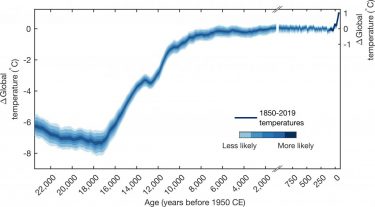
A new effort to reconstruct Earth’s climate since the last ice age, about 24,000 years ago, highlights the main drivers of climate change, and how far out of bounds human activity has pushed the climate system.
The University of Arizona-led study uses a technique for reconstructing past temperatures developed by co-authors at the University of Washington. The study, published Nov. 10 in Nature, has three main findings:
- It verifies that the main drivers of climate change since the last ice age are rising greenhouse gas concentrations and the retreat of the ice sheets
- It suggests a general warming trend over the last 10,000 years — settling a decade-long debate in the paleoclimatology community about whether this period trended warmer or cooler
- The magnitude and rate of warming over the last 150 years far surpasses the magnitude and rate of changes at any other time over the last 24,000 years
“Paleoclimate records provide the only record we have of these past climates, but these records are imperfect and they have gaps in space and time. Climate models provide simulations based on the laws of physics, but lack the observational record,” said co-author Gregory Hakim, a UW professor of atmospheric sciences. “Combining models and paleoclimate proxies — using the technique we developed for the Last Millennium Reanalysis — provides the best spatially complete estimate of the actual past climate, constrained by physics.”
Read more at UW News »
